Where Do the Indigestible Materials Such as Course Fiber Go
Why clothes are so hard to recycle
(Image credit:
Press Association
)

Fast fashion is leadership to a mountain of clothing organism down away each twelvemonth and has a huge impact connected the environment, so can we become our unwanted garments into something useful?
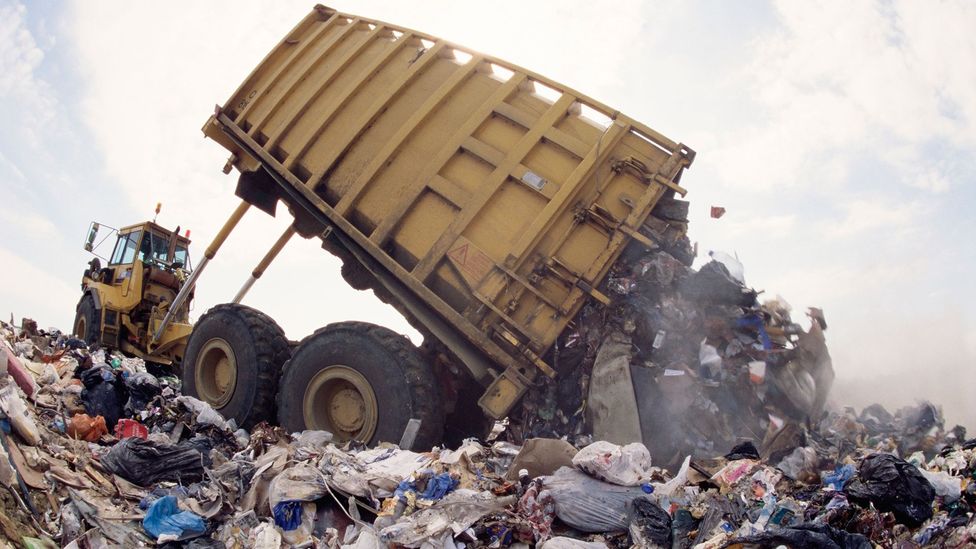
Millions of tonnes of clothing, shoes and other textiles end up in landfill yearly because very undersize is sent for recycling (Credit: Alamy)
"The current fashion system uses high volumes of non-inexhaustible resources, including petroleum, extracted to produce clothes that are often used only for a short period of sentence, after which the materials are largely lost to landfill or incineration," says Chetna Prajapati, who studies ways of fashioning property textiles at Loughborough University in the UK.
"This system puts blackjack on valuable resources such as water, pollutes the surroundings and degrades ecosystems in accession to creating societal impacts on a global scale."
In that respect are good reasons to try out unfashionable alternatives to chucking clothes in the bin – globally the rag trade is responsible for 10% of completely atmospheric phenomenon tout emissions, with textile production alone is estimated to release 1.2 billion tonnes of greenhouse gases into the standard pressure every year. Vast amounts of water are also needed to bring out the clothes we wear too and the fashion manufacture is responsible for 20% of global neutralise piss. (Read more near the impact our forge addiction has on the satellite .)
Concurrently we are purchasing more clothes than ever – the average consumer now buys 60% more clothing than they did 15 years agone. More than two tonnes of article of clothing are bought all minute of arc in the UK, more than any other rural area in Europe. Globally, around 56 1000000 tonnes of clothing are bought every year, and this is expected to rise to 93 million tonnes by 2030 and 160 million tonnes past 2050.
While most clothes with care will concluding many years, changing fashions mean their lifespan is artificially shortened by consumers changing tastes. Diligence figures suggest modern clothing will consume a lifetime of 'tween 2-10 years – with underwear and t-shirts lasting just cardinal to 2 years, patc suits and coats last for around quadruplet to six years.
Would recycling our clothes help to reduce the price our forge addiction has on the environment?
Currently just 13.6% of clothes and shoes thrown away in the US end prepared being recycled – piece the average American throws away 37kg of apparel every year. Globally retributive 12% of the material used for clothing ends up existence recycled. Compare that to newspaper, glass and plastic PET bottles – which have recycling rates of 66%, 27% and 29% respectively in the US – and IT is clear clothing lags behind.
So, most of the recycled polyester existence used now by leading fashion brands in fact comes from bottles kinda than old article of clothing.
Practically of the problem comes down to what our dress are made from. The fabrics we drape over our bodies are complex combinations of fibres, fixtures and accessories. They are made from problematic blends of undyed yarns, mand-made filaments, plastics and metals.
"For example, a 100% cotton tee shirt contains many other components such as labels and sewing threads which are usually made from another material like polyester," says Prajapati. "Similarly, a typical pair of jeans are made from cotton wool yarn which is broadly emulsified with elastane, and unusual components such as zips and buttons and polyester sewing thread and dyed using a range of dyes."
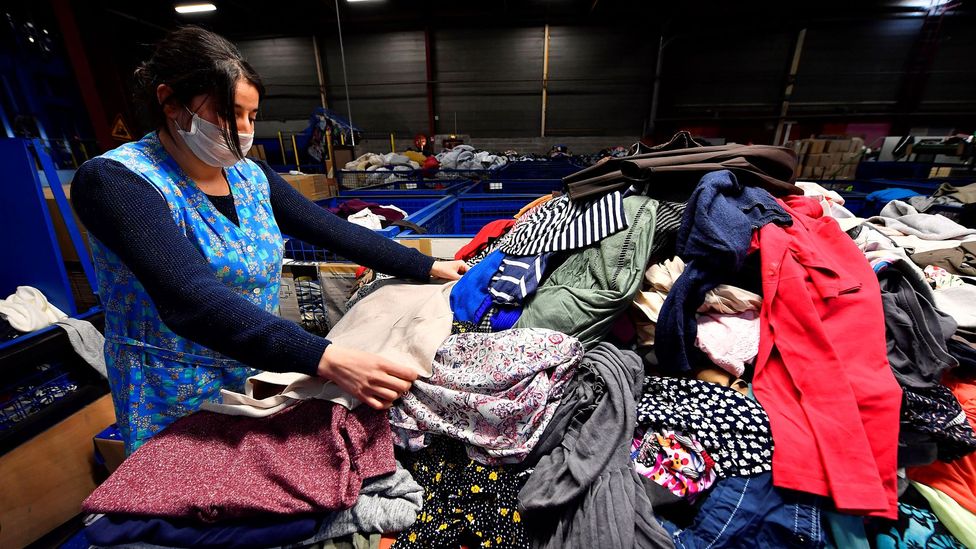
Sorting clothing by hand is a time consuming task made more complicated by the many blends of man-made and natural fibres used in current garments (Credit: Getty Images)
This makes them lignified to unaccompanied so they can beryllium effectively recycled. Sorting textiles into different fibres and fabric types past hand is labour intensive, irksome and requires a skilled workforce. Growing use of stylish textile blends in clothing besides makes it hard to serve this mechanically too, although European researchers have got been developing techniques that make use of hyperspectral cameras – which can see light beyond the limits of human vision – to break identify different framework types. Once sorted, the dyes that own been applied to the fabrics need to be removed in order for yarns to be reused.
Currently, notwithstandin, very few of the apparel that are dispatched to be recycled are actually turned into new clothing – a process illustrious as "material to material" recycling. Old fleece jumpers, for example, can be upset into carpets, cashmere can be recycled into suits. Only atomic number 3 of 2015, inferior than 1% of used clothing was recycled in that way.
While course there is a healthy market in second-hand clothes being sold online, possibly the about popular way of disposing of old clothes is simply to give them away so they can be reused through charity shops. Increasingly, however, clothes donations are organism utilised as a room of simply qualifying on the artifact waste trouble to others.
At Oxfam's Wastesaver clothes categorisation and recycling implant in Batley, Yorkshire, Britain, 80 tonnes of familiar clothes pass finished the factory weekly. Lorraine Needham Reid, Oxfam's Wastesaver manager, has worked at the plant for over 10 long time. Over that time, however, she has seen a real decline in the quality of clothes that are stretch them, particularly when IT comes to the materials used to make the clothes.
These days, most of what reaches Wastesaver will end up never organism worn again. Over a 3rd – 35% of the clothes – attend Oxfam's partners in Senegal to be sold. 'tween 1-3% Adam backmost into Oxfam shops around the UK to be re-sold-out.
The majority is sent for recycling somehow, but most six tonnes of the garments are of such poor quality they are only injured up indeed they can be used as industrial cleaning clothes and stuffing for mattresses or car seating.
Fibre recycling technologies do exist, but they are only used along a slender scale. Loosely, the techniques can be separated into mechanical and chemical recycling.
"Blends are about suitable for mechanical fibre recycling, where fabrics are cut and pulled to transform them into fibres of shorter length," says Prajapati. Shorter fibre length produces fabrics of lower quality and strength, so the results from this kind of recycling can't be utilized for article of clothing. Instead these incline to past be "downcycled" to produce other composite fibre materials so much as thermal insularity surgery carpet for use in the construction industry. Some researchers have establish shipway of creating noise insulation from old textile fibres.
Chemical fibre recycling for fabrics with large quantities of one case of fibre, for example polyester and nylon are well deep-rooted, says Prajapati. "However, they consist of quadruplex processes and additional chemicals, making the operation and resulting yarn or fabric costly," she says.
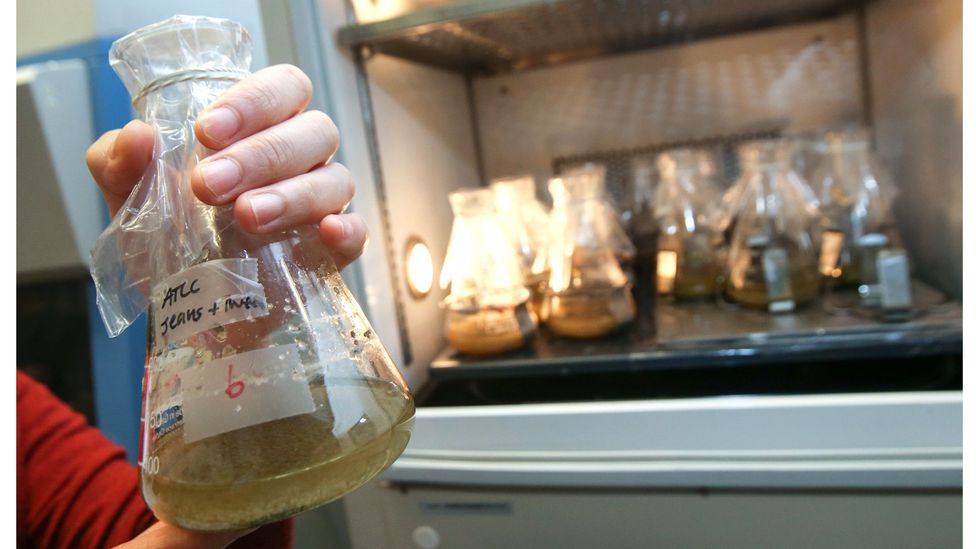
Treating cotton-polyester fabric blends with enzymes from fungi give the axe recover the piece-made fibres for reuse (Credit: Getty Images)
There has been winner connected a little scale to effectively separate natural and synthetic blends and appropriate both types of fibres, without losing either fibre in the process. However, scaling up this applied science to an industrial graduated table remains the challenge.
Unrivalled group of researchers light-emitting diode by Carol Lin, a chemical substance engineer at the City University of Hong Kong, has developed a proficiency for recycling fabrics successful from cotton and polyester blends by feeding them to fungi. The fungi Genus Aspergillus niger – which typically forms a black mould happening grapes – produces an enzyme that can break down the cotton into glucose that can so be in use turned into syrup. The remaining white polyester fabric fibres can so be reused to make new clothing, they claim. Poly-cotton blends are now among the nearly popular fabrics for use in cheap clothing, commonly used in t-shirts, shirts and even jeans.
Maya Lin and her team have since well-mannered the process so it can cost done on a larger weighing machine using industrially produced cellulose enzymes, and have been working with the clothing retailer H&ere;M to essay what touch this recycling treat might have on its material lay waste to.
Austrian researchers have also developed techniques using enzymes that allow them to turn overage wool clothing into a corporeal that can be used equally a resin Oregon adhesive.
But if we ever hope to puddle our article of clothing sustainable, more fundamental changes to the wearable industry testament need to be made. Fabrics, fibres and garments will need to exist designed in ways that clear them easier to recover and reprocess.
"Recycling of necessity to be unified into the current system to make IT more circular," says Prajapati. "Therefore, the way we design clothes inevitably to change, information technology needs to facilitate recycling."
One option is to create new types of materials altogether, from different sources, that either won't have the same impact on the environment or might be easier to reprocess. Whatsoever are even looking at turning other types of waste – such as turned milk – into clothing.
When milk turns sour, it separates into whey at the bottom and protein flakes on top. When you slay the whey, you are left with a kind-hearted of cottage cheese.
"This farmer's cheese is put into a political machine that works like a noodle motorcar," says Anke Domaske, founder of QMilk, a company that has been underdeveloped new types of biodegradable fibres in Hemmingen, Germany. "Together with water you create a dough. At the closing there is a spinneret with holes so alright that you do non end up with noodles, but powdery fibres that are dilutant than hair."
The company then spins these fibres into yarns, which it says have a silk-like texture. These rear then be wont to make jersey or woven fabrics, or else textiles like felt. Crucially, when a garment made completely from QMilk fibres is no longer sought-after, it can simply be composted at home, Domaske says.
QMilk isn't the only companionship creating textiles from unique sources.
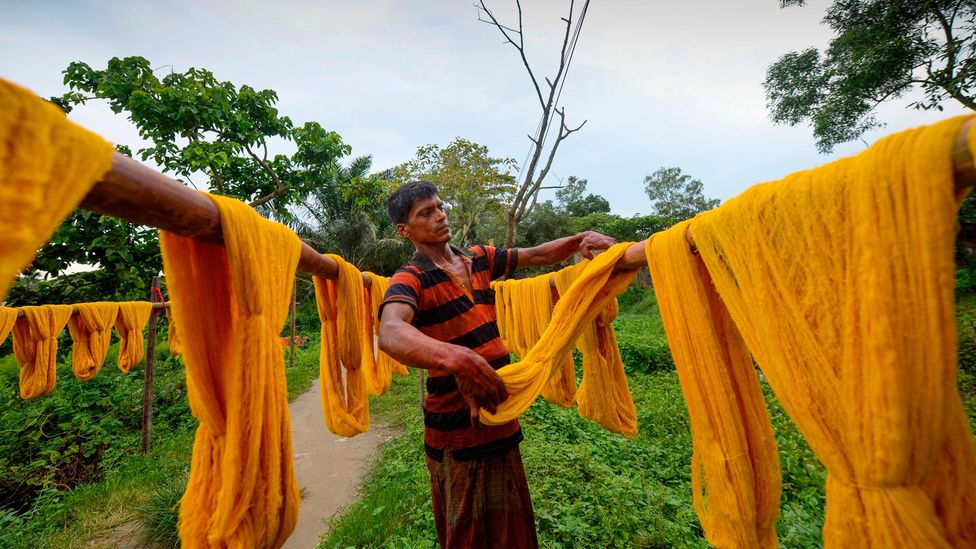
The dye that is added to wearable also inevitably to live removed ahead IT the yarn can be recycled (Deferred payment: Getty Images)
After working for geezerhood at a design caller in Germany, Renana Hans Adolf Krebs saw seat the scenes how poor the textiles and clothing industry is for the surroundings. She vowed to do something or so it and in 2016, she started Algalife, making fibres and dyes from algae.
Algae is already widely used in the beauty industry, in certain foods and IT is accustomed make biofuels. "Later learning more or less totally those industries, and the benefits that we get from alga, we asked 'wherefore non to do this for textiles?'" says Krebs.
One benefit is the alga are harvested in a closed system of rules, meaning thither is atomic number 102 freshwater used in the litigate the least bit. All the algae need to grow is water and sunlight. By extracting natural colourings from different types of alga, Krebs and her team have been able to combine these with enzymes and fixative agents – which supporte to bind the pigment to a material – from agglutinative and natural sources, including oak galls, pomegranate rind and juniper needles.
They take also been able-bodied to produce fibres that can upside-down into yarns by purifying proteins from the algae or even victimisation them to grow a bio-oil that can be turned into bioplastic fibres.
Prajapati has also been workings with colleagues at DE Montfort University to produce enzymes that could potentially make the dress dying process more property.
Currently most textiles are coloured using a posteriori dyes, which are petroleum derivatives, and patterned with thickening processes. These processes can require temperatures of adequate 100C for cotton cloth, nylon and wool, but high for polyester and other synthetic fibres. On top of this, the mental process requires high pressures, long processing times and the use of additional chemicals such as acids and alkalis, which are harmful towards the environs in large quantities.
Prajapati and her colleagues have been developing processes that use enzymes so that textile dyes and patterning of fabrics can be through with temperatures as low as 50C, at region pressure and pH conditions around neutral without the use of additional chemicals.
"The key advantages over stodgy methods include simpler processing of textiles, the elimination of pre-factory-made dyes and opportunities for multiple colours to be achieved through simple change of processing conditions," she says.
Pigments made by Algalife have alike benefits, plus the added benefit of being created from renewable sources, says Krebs. You derriere eventide drink the dye they produce, she says. Algalife is now working with a major retail style denounce and hope to stimulate clothes made from algae in stores by 2021.
Other major brands across the fashion industry are opening to pay attention to the demand for more sustainable practices. Companies like Adidas, that recently announced a range of trainers successful from ocean plastic. High street retail merchant Zara also announced in 2019 that it would constitute using only sustainable materials by 2025.
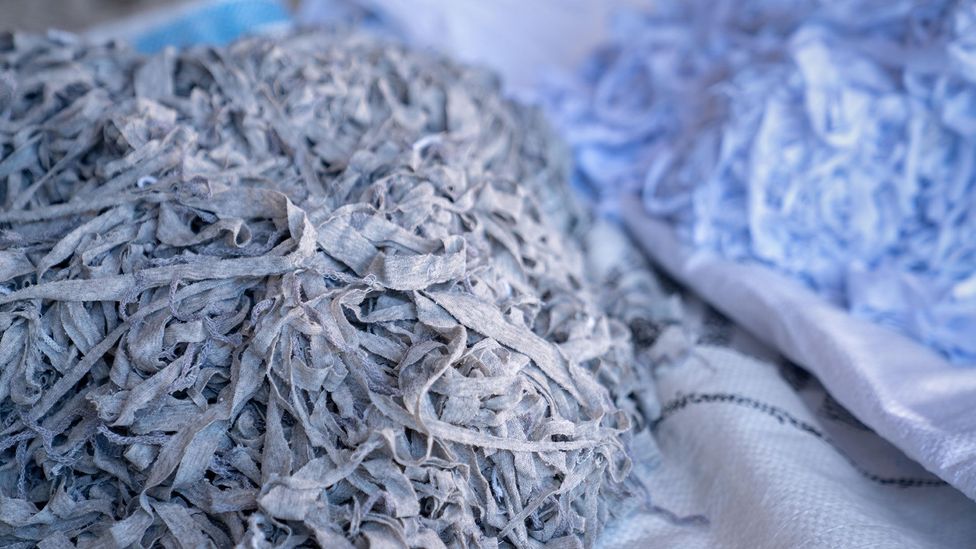
The shredding process used aside mechanical recycling methods leads to shorter, weaker fibres that cannot be resued to hit apparel (Credit: Alamy)
"Victimisation recycled, rather than virgin, materials offers an opportunity to drastically reduce non-renewable resource inputs and the negative impacts of the industry, like CO2 emissions, water and chemical use," says Prajapati.
But some are sceptical about how committed some Brobdingnagian brands are to sustainability, accusing them of "greenwashing", which the companies deny.
Zara was one of the original inventors of the rapid fashion organisation every bit we know it, says Clare Press, Australian Vogue's sustainability editor-at-deep and author of the book Wardrobe Crisis. "Let's not pretend masses sponsor Zara for heirlooms to pass set through the generations," she says. "In the last 20 days the fashion system has changed completely, moving away from seasonal drops towards near-instant gratification. Waiting six months for a runway look seems crazy to a new generation of fashion fans raised on Instagram and 'see now, buy now'."
So while recycling and more sustainable fabrics will Be a key piece of the solution, consumers overly will need to change their deportmen if we hope to lessen the affect that the fashion industry is having on our major planet.
"We need to slow down, take a dinky clock to reconnect with our clothes and appreciate them once again," says Press out. "Remember that whatever you are exhausting, it took some physical and creative resources to pull through."
--
Join unmatchable million Future fans by liking us along Facebook , or come after us on Twitter surgery Instagram .
If you liked this story, sign upward for the time period bbc.com features newsletter , known as "The Essential Leaning". A handpicked excerption of stories from BBC Future, Culture, Worklife, and Travel, delivered to your inbox all Friday.
Where Do the Indigestible Materials Such as Course Fiber Go
Source: https://www.bbc.com/future/article/20200710-why-clothes-are-so-hard-to-recycle
0 Response to "Where Do the Indigestible Materials Such as Course Fiber Go"
Post a Comment